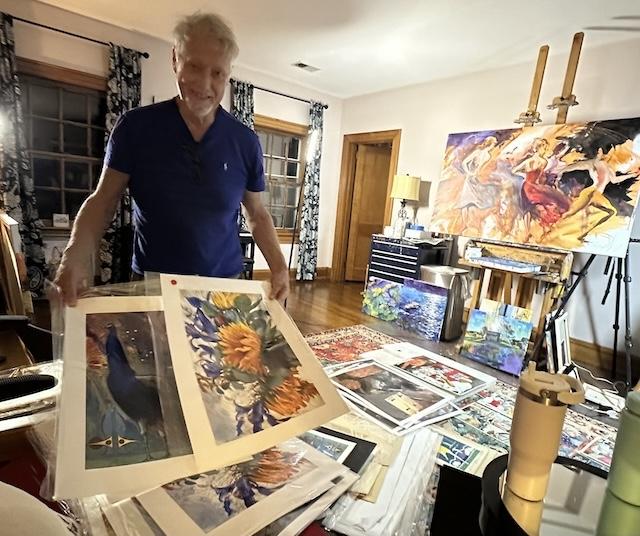James Griffin realized at a very young age that he had an artistic talent that would help him stand out from his five siblings, but it would also define his future. His passion for art would also be fueled by the experience of living in many places throughout the world and USA.
Born in Canada, his family left there, moving almost every three years, sometimes to foreign countries like Peru, Britain and Brazil and within the USA. When he arrived at the Pratt Institute in Brooklyn, New York, to attend art college, moving from São Paulo, Brazil, he considered himself a citizen of the world.
Carrying the tropical colors of South America and the deep art history he experienced in London, James says his passion for art was a constant, “helping me find my way as we traveled from place to place and discovering ways to express my excitement for the wider world in my art.”
Although he worked as a carpenter restoring Brooklyn brownstone buildings and continued to paint after college, he didn’t fit in the New York art scene. It was during this time he found a career in illustration.
James recalls how he went from nothing to being almost too busy in a very short time when his illustrations took off. He had to learn how to direct models during photo shoots, make deadlines, juggle multiple projects at once and still paint for himself.
Another recall: “I was creating scenes full of people in the big city. Crowds of pedestrians and shoppers, busy with their lives. I discovered the Lower East Side, full of street markets that reminded me of the Feiras, or street markets in Brazil. I loved the dynamic colors and the sense of action everywhere. One of the more significant paintings of that time was, Essex Street Rhythms, painted in 1979 and included in this exhibition at the William King Museum.
“Little did I know at the time, these paintings were the beginnings of a long-term project I named, ‘Passacaglia,’ after the musical form created by Medieval street musicians as they passed along the streets.”
James has progressed over the years to different forms of painting. He says his progression from the early days until now, is evident in this body of work. You can see the emphasis moving away from perfectionism toward expression.
Also, during this progression, he realized the sight in his right eye was dimming. Progressing into total blindness in that eye, he found he was still able to paint which resulted in his work becoming bolder, stronger, caring less for detail and more for expression, inner vision and movement.
James suggests some valuable lessons are to be learned from being a lifelong artist with the most important being to not ever give up, be true to yourself and your art but don’t be too serious.
His favorite quote comes from Picasso, of course: “Inspiration will come, but it’s best if it finds you working.”
His best advice, however, is to play and enjoy life because he says, “art is not life! Artists tend to think it is, but now I think of it as a practice, like meditation, something I do as part of a life that includes time for family, fun and adventure. Life is for living. Art is to help us live.”
James Griffin will continue to experience life as fully as possible, all the joyous things along with the sad things. He says he will keep going with paint and to help others find their creative selves in the classes he teaches, while enjoying family as the most wonderful thing to happen to him.
James Griffin show Tapestry of Movement at the William King Museum in Abington, Virginia, opened on August 22, 2024. The show contains paintings that span five decades, some of which were never seen by the public.
A second show will be held at the McDaniel College in Maryland in February, featuring his romance work.
He owns the Griffin Art Gallery in the historic downtown of Jonesborough, Tennessee.
On Saturday afternoons you can find him at his gallery teaching, “Painting with Expression” classes.
- Debbie and James Griffin
- James and Debbie Griffin with Jeanna, Penelope and Isaac Labossiere
All of us have a story and I want to tell yours! Send them to susan@knoxtntoday.com.



